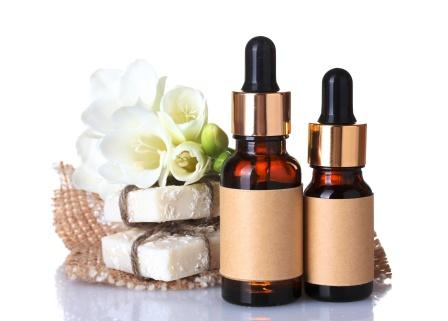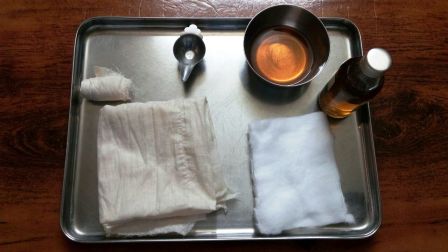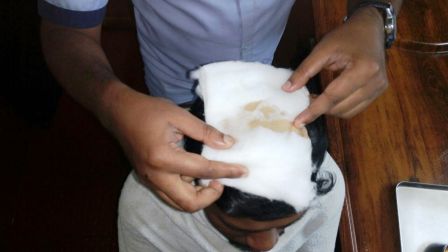Local Pichu Treatment For Painful Joints, Ligaments And Muscles
Article by Dr Raghuram Y.S. MD (Ay) & Dr Manasa, B.A.M.S
Table of Contents
Introduction
Pichu means padding or sponging. It is a unique therapy developed on the basis of ancient wisdom of Ayurveda. It falls in the category of Bahya Snehana (external application of medicated oils).
Here a sterile cotton pad is dipped in Ayurvedic oil and placed over the painful joint or sore muscles in conditions like low back pain, degenerative arthritis like osteoarthritis of knee joint or hip joint etc.

The cotton pad is allowed to stay in place from a few minutes to few hours. A bandage is tied over the pad enclosing it along with the painful part to avoid the pad from falling off from its position. With modulation it can be used over all the painful parts.
Origin
The concept of ‘Sthanika Pichu’ or ‘local oil padding’ is a concept modified from ‘Shiro Pichu’ i.e. ‘oil padding of crown of head’. Shiro Pichu is a type four types of oil treatment of head – called Murdha Taila
Read related: Moordha Taila, Murdhni Taila: Ayurvedic Oil Treatment On Head
In local Pichu, the concept of Murdni Taila is modified in a convenient form so as to use the method in effectively healing sore joints and muscles or painful bony lesions.
Procedure
Method of doing Sthanika Pichu
As any treatment in Ayurveda, Sthanika Pichu too should be handled in 3 stages i.e.
- Purva Karma (pre-treatment arrangements and procedures)
- Pradhana Karma (treatment procedure)
- Paschat Karma (post treatment procedures and follow up’s)
Purva karma
Examination – A thorough examination of the disease (vyadhi pareeksha) and patient (atura pareeksha or rogi pareeksha) is done.

Selection – The patient fit to undergo sthanika pichu is selected. Since medicated oils and ghee will be used in the treatment patients with ama (circulating immature essence of digestion), excessive kapha and meda shall be avoided or dealt with caution.
Photo courtesy: Dr Linda Abid, Almas Ayurveda, Kottakkal – [email protected]
To whom local pichu treatment is useful?
Vata type of pains – pain, swelling and degeneration of joints and soft tissues caused due to predominant vitiation of Vata and neurological pains can be considered
Vata Prakriti people who show signs of early degeneration of bones and joints and weakness of muscles
Pitta associated with Vata conditions of joints – Painful conditions of joints and spine wherein there is involvement of pitta along with vata. These conditions present with degeneration changes along with inflammation. In these conditions the oils and or ghee which have properties of mitigating both vata and pitta shall be selected.
Rukshana – A short course of drying therapy like ruksha sweda (followed by abhyanga or massage for few minutes) shall be done. It is helpful in resolving the ama in the joints or to remove swelling caused due to some fluids around the joints. There may be a slight increase of pain in pure Vata conditions but that will come down once snehana is started. It is better to avoid rukshana in pure Vata conditions or a short single sitting shall be done. Snehana (sthanika pichu) i.e. local oleation acts best on dried surface following rukshana. Valuka Sweda or Dhanyamla Dhara can be considered.
Read related: Rookshana Therapy – Drying Principle For Excess Oiliness
Swedana – Fomentation or sweating treatment, if given before and after Sthanika Pichu, works wonders. It enhances the effect of treatment. Pain relief and reduction of stiffness and other related complaints can be appreciated better. Swedana enhances blood circulation around the painful joints. Nadi Sweda (tubular fomentation) or Patra Pinda Sweda (leaf bolus fomentation) or hot water bag can be applied. The surface should be wiped off and dried before administering Pichu.
Materials needed
Sterile Cotton Pads
Bandaging clothes
Pan for heating oil
Medicated oils / ghee
Small bowls and spoons for collecting and dispensing oils
Materials needed for Rukshana and Swedana

Pradhana Karma
Pradhana Karma – main procedure:
The medicated oil or ghee selected for the treatment is indirectly heated. The required amount of oil is taken in a small bowl. This small bowl consisting of oil is placed in a vessel having hot water. The temperature of the oil is checked. When it gets warm (care should be taken that it is not hot enough so as to burn the skin), the oil bowl is removed.
A sterile cotton pad of the dimension of the joint over which the procedure is intended to be done is selected. A longer pad might be needed in case the whole spine (back bone) is the point of treatment. Alternatively 3-4 pads can be vertically padded over the spine from top to bottom.
The cotton pad is dipped in the oil. The pad is squeezed to remove excessive dripping of oil.
The pad dipped in oil is kept over the painful joint / body part.
If the oil is dripping from the sides of the pad, it should be regularly wiped.
To keep the temperature of the pad constantly warm, warm oil is continuously poured over the pad. Alternatively the pad which loses the temperature shall be replaced with another pad dipped in warm oil.
A bandage cloth is taken and tied around the joint with pad in position. This is done to avoid the pad from falling off from its position. This is done in case the patient needs to be discharged or if the patient is doing the treatment by self at home, while attending the office or work simultaneously or when maintenance of temperature over the afflicted area is not intended.
The padding is done for 45 minutes to 1.5 hours at a stretch. In chronic conditions the pad shall be left in place overnight or from morning to evening according to the convenience of the patient.
Paschat Karma
Removal of Padding – After the stipulated time, the padding is removed. The oil is wiped off.
Swedana – Swedana is administered to enhance the effect. (Swedana may be skillfully thought of, it is not mandatory).
Virechana – Daily purgation is administered, preferably at night with herbal laxatives like Gandharvahastadi taila, Nimbamritadi Eranda tailam etc. These oils not only control Vayu but also have disease modifying role.
Vasti – Herbal enemas in the form of Anuvasana / Sneha Vasti (oil enemas) and Kashaya Vasti / Asthapana Vasti (decoction enemas) shall be given. Vasti is the best treatment for Vata vitiation. Matra Vasti or daily enema of low dose sneha vasti is an ideal choice.
Shamana Aushadhas – Disease modifying medicines shall be administered in the follow up
Rasayana – Immune-modulators or rejuvenators are given to strengthen the joints, bones and soft tissues
Follow up visits or continued treatments at home – shall be advised
Sthanika Pichu indications
Indications of Sthanika Pichu
Kati Pichu (oil padding done in low back region) in
- Low back pain (lumbago)
- Lumbar spondylosis
- Sciatica
- Sacro-iliac joint pain
- Coccydynia (tail bone pain)
- Intervertebral disc prolapse (IVDP)
- Sprains and strains
Prishta Pichu (oil padding done over the entire vertebral column or backbone) in –
- Pain in or along the entire spine
- Spine pain due to postural changes
- Sprains and muscle strains
Sandhi Pichu in Sandhigata Vata (oil padding done on sore and stiff joints in osteoarthritis) –
- Osteoarthritis of Knee joint (Janu Sandhi Pichu)
- Hip joint osteoarthritis (Vankshana Sandhi Pichu)
- Osteoarthritis of joints of the extremities (Shaka gata sandhi pichu)
Sandhi Pichu in Sandhi Shula (vedana) (oil padding done on painful joints and bones –
- Ankle pain (Gulpha Pichu)
- Shoulder pain (Kaksha Sandhi Pichu)
- Elbow pain (Kurpara Sandhi Pichu)
- Wrist joint pain (Manibandha Sandhi Pichu)
- Calcaneal pain (Padamula Pichu)
Oils used
Oils used for Sthanika Pichu
Sesame oil and Go Ghrita (ghee of cow, in pitta association) are effective and cost effective too. For better results it is always better to use the medicated oils which have disease modifying role. Below mentioned are some of the medicated oils which come in handy for Sthanika Pichu. The doctor shall choose appropriate oil or ghee depending on the clinical diagnosis of the condition being treated and after judging the dosha involvement in the pathogenesis of that ailment. One or more oils may be combined for better effect. Some patent oils which I have mentioned in the list can also be used either singly or in combination with one or more of the classical oils.
Effective Oils and Ghee
- Ksheerabala Tailam
- Mahanarayana Tailam
- Kottamchukkadi Tailam
- Mahanarayana Tailam
- Balashwagandha Tailam
- Sahacharadi Tailam
- Dhanwantaram Tailam
- Eranda Tailam
- Lakshadi Tailam
- Bala Tailam
- Murivenna
- Pinda Tailam
- Yashtimadhu Tailam
- Guggulutiktakam Ghritam
Proprietary oils useful in oil padding or Pichu
- Arnopen liniment (Phyto Pharma)
- Arthrum oil (Vital care)
- Arthorub liniment (AVN)
- Dazzle oil (Vasu)
- Orthofit oil / gel (Fizikem)
- Penwel oil (Ayulabs)
- Pyroflex gel (Solumiks)
- Rheumat liniment (Nagarjuna)
- Rhuma oil (Baidyanath)
- Rumalaya gel (Himalaya)
Advantages
Advantages of Sthanika Pichu
Cost reliable – In convenient anatomical sites where construction of cabin from wet flour is possible, oil pooling or sthanika vasti is done. The intention is to provide maximum contact and retention period of the medicated oils with the painful structure, be it joint or bone or soft tissues. Example, Kati Vasti is done for low back pain, sciatica and sacro-iliac pain. Greeva Vasti is done for neck pain. Janu Vasti is done for knee osteoarthritis and knee pain. These treatments are heavy on one’s purse. They are costly treatments and everyone cannot afford. Sthanika Pichu are cheaper, yet provide good results in terms of relief from pain and catches in degenerative and neurological pains. Sthanika Pichu provides a best alternative to Sthanika Vasti or Abhyanga in terms of cost-reliability and is equally effective.
Read related: Shiro Pichu: Benefits, Procedure, Mode Of Action
Fewer materials needed – Sthanika Pichu needs fewer materials and cheaper ones too. Therefore it cuts short the expenditure on these things also.
Easy to do – Sthanika Pichu is easy to conduct and doesn’t need a physician or masseurs (therapists) to spend time and energy in doing the treatment. It reduces man-power. The patient can do it himself or herself.
Can be done at home – Sthanika Pichu saves the patient’s time. He or she need not visit hospital or spend time in the hospital to get this treatment done. It can be done at home.
Provides extended contact time – Unlike Sthanika Vastis and external procedures like abhyanga etc, Sthanika Pichu provides an advantage in providing an extended contact time. Depending on the severity and chronicity, the pichu can be left in place for more time since there is no hurry in removal.
Note – Though Sthanika Pichu can be done by self and at ones home, it should be done after consulting a doctor. The condition needs to be diagnosed properly. After diagnosis, a doctor may prescribe suitable oils to be used. It is difficult for the patient to make choice of medicine. Many times Sthanika Pichu might not be just enough when the condition is more severe and chronic with complications. It may need disease modifying medicines, treatments like Panchakarma measures, a suitable diet and exercise plan. This is where an experienced doctor fits in.
Clinical experience
My clinical experience in conducting Sthanika Pichu
Sthanika Pichu is one of my favourite picks in the practice. Though it is cost effective, being in a corporate arena I have always advised Pichu to be tried as a first-hand remedy to most of my clients who are fit to undertake this treatment, immaterial of socio-economic status. Primary focus was to save the time of the patient and enable them to get the treatment done with the help of their family members at their home, at their convenient time. In chronic and stubborn cases and in cases wherein I felt that Sthanika Pichu is not enough, I have avoided suggesting this. I have referred these patients for aggressive approaches like Virechana, Vasti, Abhyanga and Sthanika Vasti. For these patients I have brought Sthanika Pichu in the follow-up maintenance. I have always blended Sthanika Pichu with effective disease-modifying medicines, dietetic recommendations, lifestyle and posture changes, exercise, Yoga and immune-modulators as and when required. The aim is always to provide a comprehensive relief to the ailing patient.
With Sthanika Pichu, I have found a great amount of success in my clinical practice. I have generally preferred doing it in knee pain and osteoarthritis, low back pain, sacroiliac pain, shoulder pain and neck pain, though it can be preferably administered at any painful area. I also felt that patients are more convenient and happy to conduct this treatment at home. This also gives them a good range of confidence and they could monitor the healing process as the treatment is conducted in their comfort zone. Immediate mobilization is also avoided giving rest to the sore joints, unlike when conducted in hospitals.
Just Before Finishing –
Ayurveda is an abode of effective remedies. Time and again the concepts have been revisited and reviewed for the betterment of mankind, to provide a comprehensive cure. Sthanika Pichu is one such modified concept which gives the ailing patient an easy and effective way of dealing with painful conditions of bones and joints. This article highlights the dimensions of usage of Sthanika Pichu in various painful conditions.
Click to Consult Dr Raghuram Y.S. MD (Ayu)









